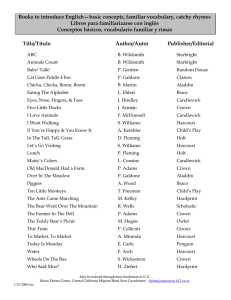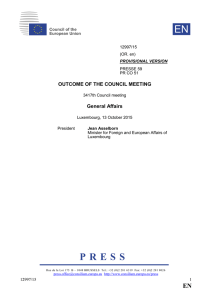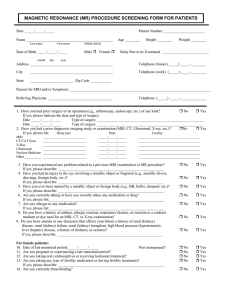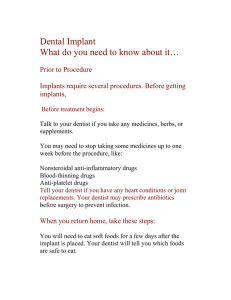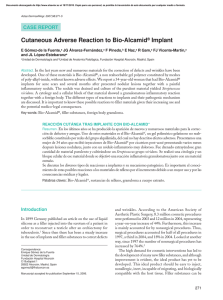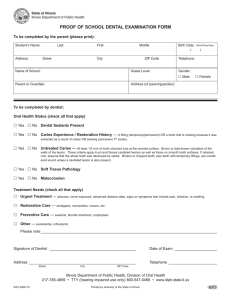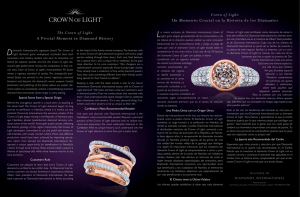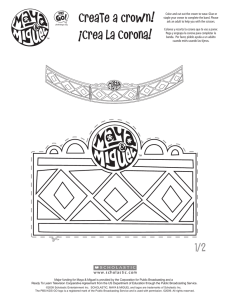A Chairside Technique to Preserve the Anatomy of the Pre
Anuncio
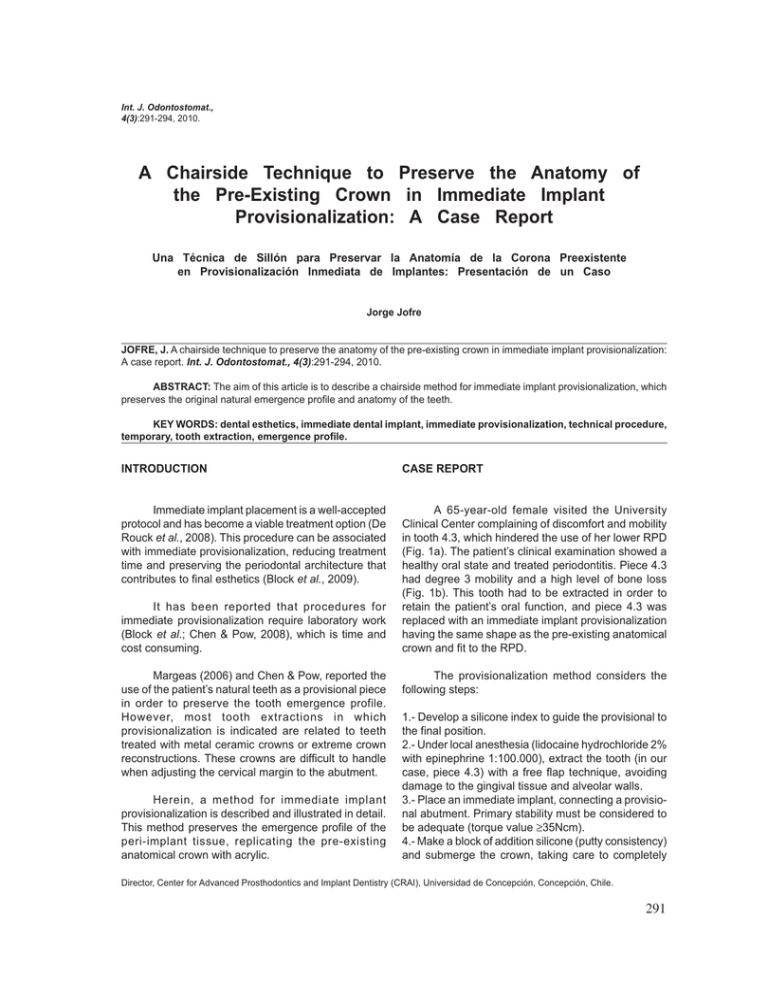
Int. J. Odontostomat., 4(3):291-294, 2010. A Chairside Technique to Preserve the Anatomy of the Pre-Existing Crown in Immediate Implant Provisionalization: A Case Report Una Técnica de Sillón para Preservar la Anatomía de la Corona Preexistente en Provisionalización Inmediata de Implantes: Presentación de un Caso Jorge Jofre JOFRE, J. A chairside technique to preserve the anatomy of the pre-existing crown in immediate implant provisionalization: A case report. Int. J. Odontostomat., 4(3):291-294, 2010. ABSTRACT: The aim of this article is to describe a chairside method for immediate implant provisionalization, which preserves the original natural emergence profile and anatomy of the teeth. KEY WORDS: dental esthetics, immediate dental implant, immediate provisionalization, technical procedure, temporary, tooth extraction, emergence profile. INTRODUCTION CASE REPORT Immediate implant placement is a well-accepted protocol and has become a viable treatment option (De Rouck et al., 2008). This procedure can be associated with immediate provisionalization, reducing treatment time and preserving the periodontal architecture that contributes to final esthetics (Block et al., 2009). A 65-year-old female visited the University Clinical Center complaining of discomfort and mobility in tooth 4.3, which hindered the use of her lower RPD (Fig. 1a). The patient’s clinical examination showed a healthy oral state and treated periodontitis. Piece 4.3 had degree 3 mobility and a high level of bone loss (Fig. 1b). This tooth had to be extracted in order to retain the patient’s oral function, and piece 4.3 was replaced with an immediate implant provisionalization having the same shape as the pre-existing anatomical crown and fit to the RPD. It has been reported that procedures for immediate provisionalization require laboratory work (Block et al.; Chen & Pow, 2008), which is time and cost consuming. Margeas (2006) and Chen & Pow, reported the use of the patient’s natural teeth as a provisional piece in order to preserve the tooth emergence profile. However, most tooth extractions in which provisionalization is indicated are related to teeth treated with metal ceramic crowns or extreme crown reconstructions. These crowns are difficult to handle when adjusting the cervical margin to the abutment. Herein, a method for immediate implant provisionalization is described and illustrated in detail. This method preserves the emergence profile of the peri-implant tissue, replicating the pre-existing anatomical crown with acrylic. The provisionalization method considers the following steps: 1.- Develop a silicone index to guide the provisional to the final position. 2.- Under local anesthesia (lidocaine hydrochloride 2% with epinephrine 1:100.000), extract the tooth (in our case, piece 4.3) with a free flap technique, avoiding damage to the gingival tissue and alveolar walls. 3.- Place an immediate implant, connecting a provisional abutment. Primary stability must be considered to be adequate (torque value ≥35Ncm). 4.- Make a block of addition silicone (putty consistency) and submerge the crown, taking care to completely Director, Center for Advanced Prosthodontics and Implant Dentistry (CRAI), Universidad de Concepción, Concepción, Chile. 291 JOFRE, J. A chairside technique to preserve the anatomy of the pre-existing crown in immediate implant provisionalization: A case report. Int. J. Odontostomat., 4(3):291-294, 2010. Fig. 1. a) Preexisting crown supporting a removable partial denture (RPD). Fig. 1. b) Initial Xray. Fig. 2. A technique to elaborate a provisional restoration. A) Extracted tooth inserted in putty silicone (Speedex; Coltène / Whaledent, Alstätte, Switzerland); B) After removing the crown from the silicone block, fluid acrylic (Alike; GC America, Alsip, IL) was poured into the mold; C) Extracted crown and hollowed replica. 292 cover the emergence profile (Figure 2a). 5.- Remove the crown from the silicone and fill the mold with acrylic fluid (Alike; GC America, Alsip, IL) (Fig. 2b). 6.- Remove the acrylic duplicate from the silicone block and hollow out (Fig. 2c, d). 7.- Use a silicone index to position the tooth. 8.- Reline the crown with acrylic on the provisional abutment and wait for the acrylic setting time, making slight vertical movements to avoid retention. 9.- Remove excess acrylic, and polish the acrylic crown outside of the mouth. 10.- Use provisional cement (TempoCem®NE, DMG, Hamburg, Germany) on the crown. 11.- Check that the provisional has no contact in centric and eccentric occlusion. JOFRE, J. A chairside technique to preserve the anatomy of the pre-existing crown in immediate implant provisionalization: A case report. Int. J. Odontostomat., 4(3):291-294, 2010. Fig. 3. Immediate implant provisionalization fitting an existing RPD after three months of clinical use. b) Radiographic control. 12.- The patient was monitored three times: at 48 hours, one week, and three months after surgery. No pain or signs of infection were found. The patient did not report any discomfort with her prosthesis and indicated a high level of satisfaction with the immediate treatment and the aesthetic results obtained (Fig. 3a, b). DISCUSSION ACKNOWLEDGEMENTS Immediate provisionalization is considered to be an advantageous procedure for aesthetic results in immediate implant placement. Despite reports of techniques and procedures that use the patient’s teeth, these cannot always be recovered. The method described offers a chairside alternative for fabricating an immediate provisional for a single implant, replicating the pre-existing anatomical crown with acrylic. Acrylic is easier to handle for this procedure, and allows the periodontal structures to be preserved. The author thanks Paula Quintana (DDS) and Jeanette Fuentes (DDS) for critical readings of this manuscript and Claudia Asenjo (MS) for drafting the manuscript. The applications of this technique are extensive, and can be used on anterior and posterior teeth as well as fixed partial prosthetics and bridges. RESUMEN: El objetivo de este artículo es describir un método directo en el sillón de provisionalización inmediata del implante, que conserva el perfil de emergencia natural original y la anatomía de los dientes. JOFRE, J. Una técnica de sillón para preservar la anatomía de la corona preexistente en provisionalización inmediata de implantes: Presentación de un caso. Int. J. Odontostomat., 4(3):291-294, 2010. CONCLUSION This chairside technique replicates the preexisting natural or restored teeth, preserving the original natural emergence profile and anatomical crown. PALABRAS CLAVE: estética dental, implantes dentales inmediatos, provisionalización inmediata, procedimiento técnico, extracción de dientes, perfil de emergencia. 293 JOFRE, J. A chairside technique to preserve the anatomy of the pre-existing crown in immediate implant provisionalization: A case report. Int. J. Odontostomat., 4(3):291-294, 2010. REFERENCES De Rouck, T.; Collys, K. & Cosyn, J. Single-tooth replacement in the anterior maxilla by means of immediate implantation and provisionalization: a review. Int. J. Oral Maxillofac. Implants, 23:897-904, 2008. Block, M. S.; Mercante, D. E.; Lirette, D.; Mohamed, W.; Ryser, M. & Castellon, P. Prospective evaluation of immediate and delayed provisional single tooth restorations. J. Oral Maxillofac. Surg., 67:89-107, 2009. Chen, Z. F. & Pow, E. H. A technique for the fabrication of an immediate implant-supported provisional restoration using a fractured natural tooth. J. Prosthet. Dent., 100:157-8, 2008. Margeas, R. C. Predictable periimplant gingival esthetics: use of the natural tooth as a provisional following implant placement. J. Esthet. Restor. Dent., 18:5-12, 2006. 294 Correspondence to: Dr. Jorge Jofre Center for Advanced Prosthodontics and Implant Dentistry (CRAI) Universidad de Concepción Concepción CHILE Phone: (56-41) 220-3770 Fax: (56-41) 220-3706 Email: jjofre@udec.cl Received: 05-11-2010 Accepted: 27-11-2010

